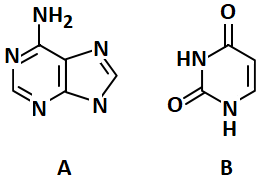A. 
B. 
C. 
Which of the above is Zwitterionic form?
(1) B
(2) C
(3) A
(4) All are correct

B.

C.

Which of the above is Zwitterionic form?
The quaternary structure of a protein:
| 1. | Consists of 4 subunits - hence the name quaternary |
| 2. | Is unrelated to the function of the protein |
| 3. | Both (a) and (b) |
| 4. | Depends on the 1° structure of subunits |
Adult human haemoglobin consists of:
| 1. | 2 subunits (β, β) |
| 2. | 2 subunits (α, α) |
| 3. | 4 subunits (2α, 2β) |
| 4. | 3 subunits (2α, 1β) |
Lecithin is:
(1) Phospholipid
(2) Carbohydrate
(3) Protein
(4) Amino acid

The above diagram represent the nitrogenous bases. Identify the correct combination:
1. A = Adenine; B = Thymine
2. A = Guanine; B = Thymine
3. A = Adenine; B = Uracil
4. A = Guanine; B = Uracil
Which one of the following is the diagrammatic representation of a nucleotide?
1.
2.
3.
4.
Go through the following statements-
A. Primary metabolites are biochemicals formed as intermediates and products of normal vital metabolic pathways of organisms
B. Plant tissues produce only secondary metabolites
C. Secondary metabolites have restricted distribution in the plant kingdoms only.
D. Secondary metabolites are derivatives of primary metabolites.
E. Many plants, fungi and microbes synthesise secondary metabolites.
F. No secondary metabolite has ecological importance.
G. We understand the role of all secondary metabolites in the host organisms.
H. Many secondary metabolites are of economic importance to us.
Which of the above statement are wrong?
1. A, B, C are wrong
2. D, E, F are wrong
3. A, D, E are wrong
4. B, C, F, G are wrong
Which one of the following is not a polymeric substance?
(1) Rubber
(2) Morphine
(3) Gum
(4) Cellulose
Which one is heteropolymer?
| 1. | Chitin | 2. | Polyethylene |
| 3. | Peptidoglycan | 4. | Inulin |
Which one is correct?
1. Inorganic catalysts work efficiently at high temperature and high pressure while enzymes get damaged at high temperature (above 40°C)
2. Thermophilic organisms living in hot vents and sulphur springs have enzymes that are stable and retain their catalytic power even at high temperature (80 - 90°C)
3. Ribozymes are nucleic acids behaving like enzyme
4. All are correct









